Here’s a bit of movie trivia for you: What do “Star Wars,” “The Adventures of Priscilla, Queen of the Desert,” and the original “West Side Story” story have in common? They’ve all won an Oscar for Best Costume Design.
A new film will be joining their ranks this weekend during the 95th Academy Awards, and you can see some of its costumes on display at the “Art of Costume Design in Film” exhibit at the Fashion Institute & Design Merchandising (FIDM) Museum through May 6, 2023. All five Academy Award nominees for Costume Design will be featured at the free exhibit alongside dozens of designs from 18 of the hottest films from this season.
FIDM Chair of Fashion Design Nick Verreos spotlights some of the best costumes on display at the exhibit this year and the stories behind them.
Who developed the costumes in the top nominated film “Everything Everywhere All at Once?”
Nominated for costume design [for the film] is Shirley Kurata. She actually comes from the styling world. She styled Billie Eilish for her world tour and also [celebrities like] Pharrell Williams and Lena Dunham.
She did a lot of research for the movie. She researched Harajuku fashion and blogs like Chinatown Pretty. If you do not know that blog, you need to look at it. [Kurata] was inspired by costume designer Eiko Ishioka who did Coppola’s “Dracula.”
We have an Elvis costume that is worn in the movie. Jobu Tupaki is trying to make her mom, Michelle Yeoh, mad and she has this … actual Elvis impersonator costume, and [design team] customized it to the petite Stephanie Hsu’s body.
Another one that we have is “Goth Jobu.” It’s a black outfit with a spike choker. The ruffle top from it is actually from Comme des Garçons, so it comes from high fashion and Shirley Kurata’s kit.
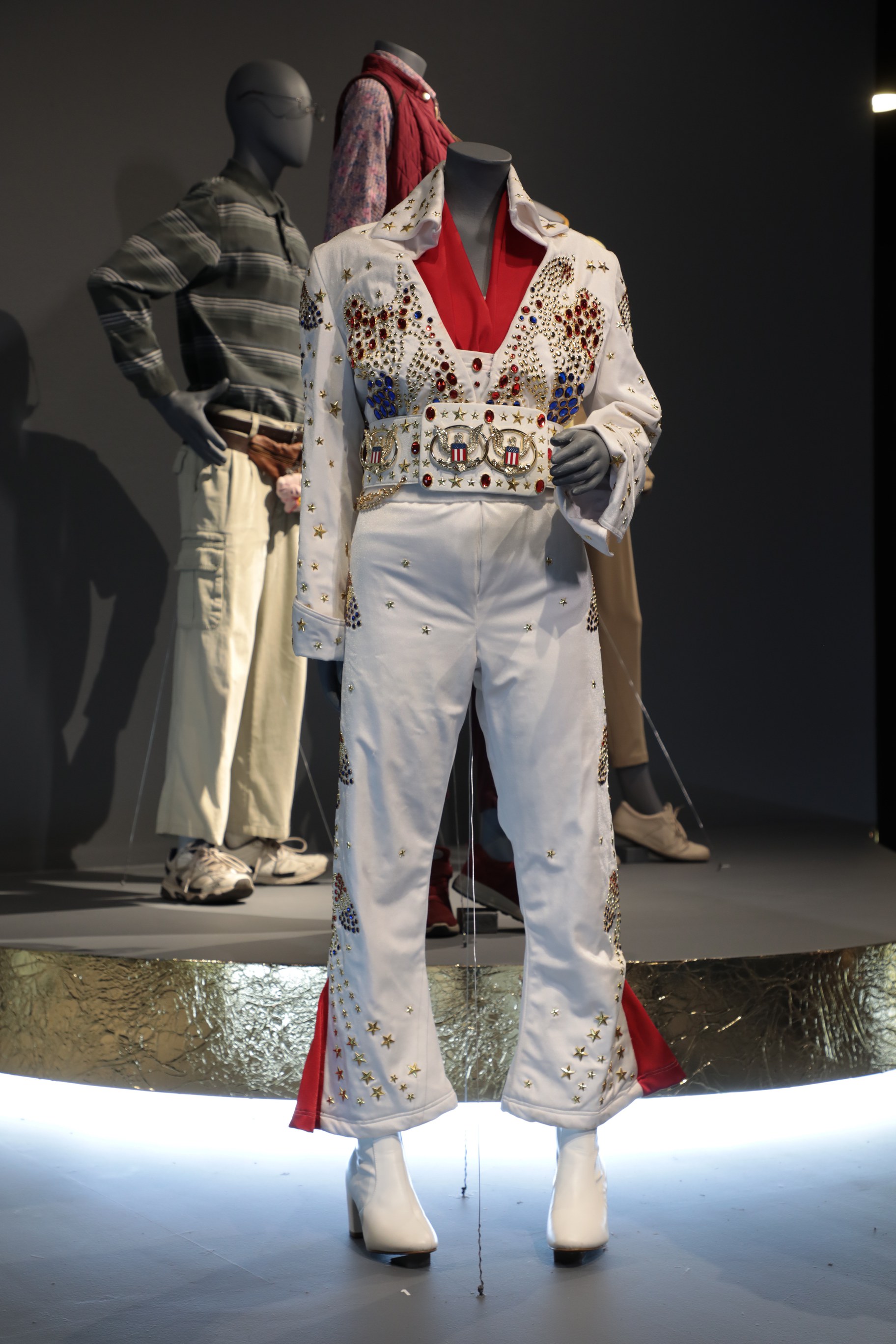
Costume designer and stylist Shirley Kurata did extensive research for multiverse-roving attire like this Elvis jumpsuit in the hit film “Everything Everywhere All at Once.” Photo by Alex J. Berlinger/ABImages, courtesy of the FIDM Museum.
Is the purple dress that Angela Bassett wears in “Black Panther: Wakanda Forever” on display?
It’s one of my favorite costumes actually and I think it’s also one of the costume designer Ruth E. Carter’s favorite costume.
The dress is purple velvet — purple is the color of royals — and it has golden embroidery. It features a 3D printed isicholo, which is a Zulu headdress that married Zulu women wear. It was made by architect Julia Koerner.
[Carter] also collaborated with an Indian designer to make four of Angela Bassett’s gowns, including a purple one we have on exhibition, named JJ Valaya. He’s known as the Armani of India.
Ruth E. Carter told me that originally [the gown] wasn’t supposed to be what Angela Bassett’s character, Queen Ramonda, wears when she enters the U.N. She was going to wear a fierce suit naturally, but the director saw the sketch of the gown and said, “No, I think it would be amazing if she actually walked into the U.N. with this long purple regal gown to really make an entrance.”
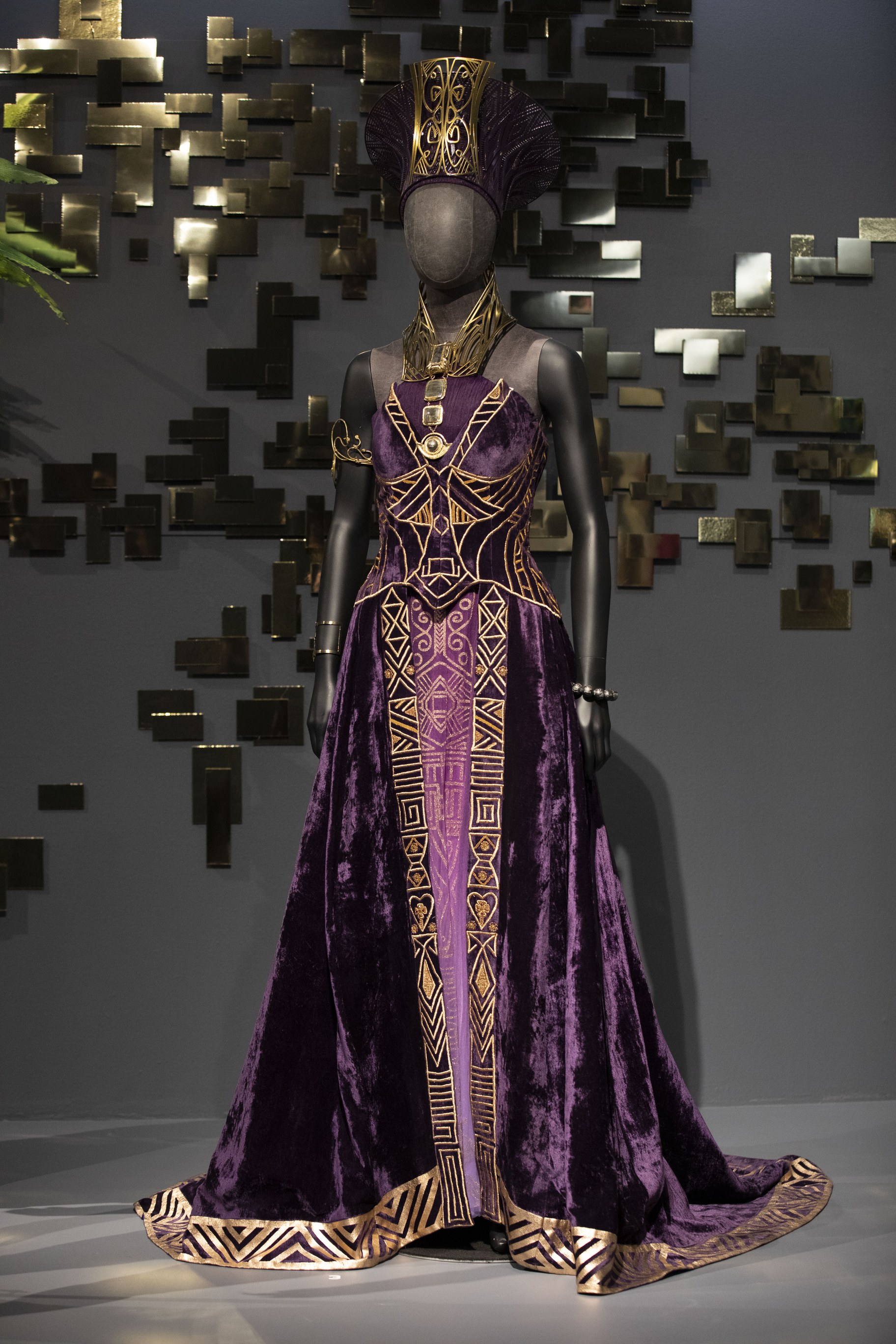
Award-winning costume designer Ruth E. Carter could win another Oscar for Best Costume Design this year for her work on dresses like this one that Angela Bassett’s Queen Ramonda wore in the film “Black Panther: Wakanda Forever.” Photo by Alex J. Berlinger/ABImages, courtesy of the FIDM Museum.
Why does the CGI film “Avatar: The Way of Water” have real costumes?
The costume designer Deborah Scott has been working on [the film] since 2018. Scott and her team created all of the live action costumes worn by the humans and the Na’vi. She had to create each and every one of them because [the actors] had to do fittings. They all had to wear the actual costumes to see how they moved even though they never appeared on screen. So every costume, including the props, the masks, and the helmets, took about a year to make.
After they had fittings it was all given to post-production to go digital. But yes, even though it was all CGI, the actual costumes were physically made.
![]()
All of the costumes on the film “Avatar: The Way of Water” were physically made by designer Deborah Scott even though the movie is CGI, says Nick Verreos. Photo by Alex J. Berlinger/ABImages, courtesy of the FIDM Museum.
Who is behind the designs on the film “Top Gun: Maverick?”
Marlene Stewart, who actually styled Madonna back in the day. She did several of her concerts as well as some of her videos, including “La Isla Bonita.”
When it comes to [costuming] Tom Cruise, she said it was one of the hardest, most important tasks she had to do — especially the flight jacket. She called it the “frankenjacket.” She said she used elements from 40 period pieces and she had several vendors that specialize in sourcing military jackets. So what she says about why she calls it a ‘frankenjacket’ is because she got a sleeve here, a collar there, a pocket there.
The original movie was published in 1986, so even the silhouette of the flight jacket had to be updated. Another tidbit: The actual flight suits that Tom Cruise wore – this is how special Mr. Cruise is – they were lined in cashmere.
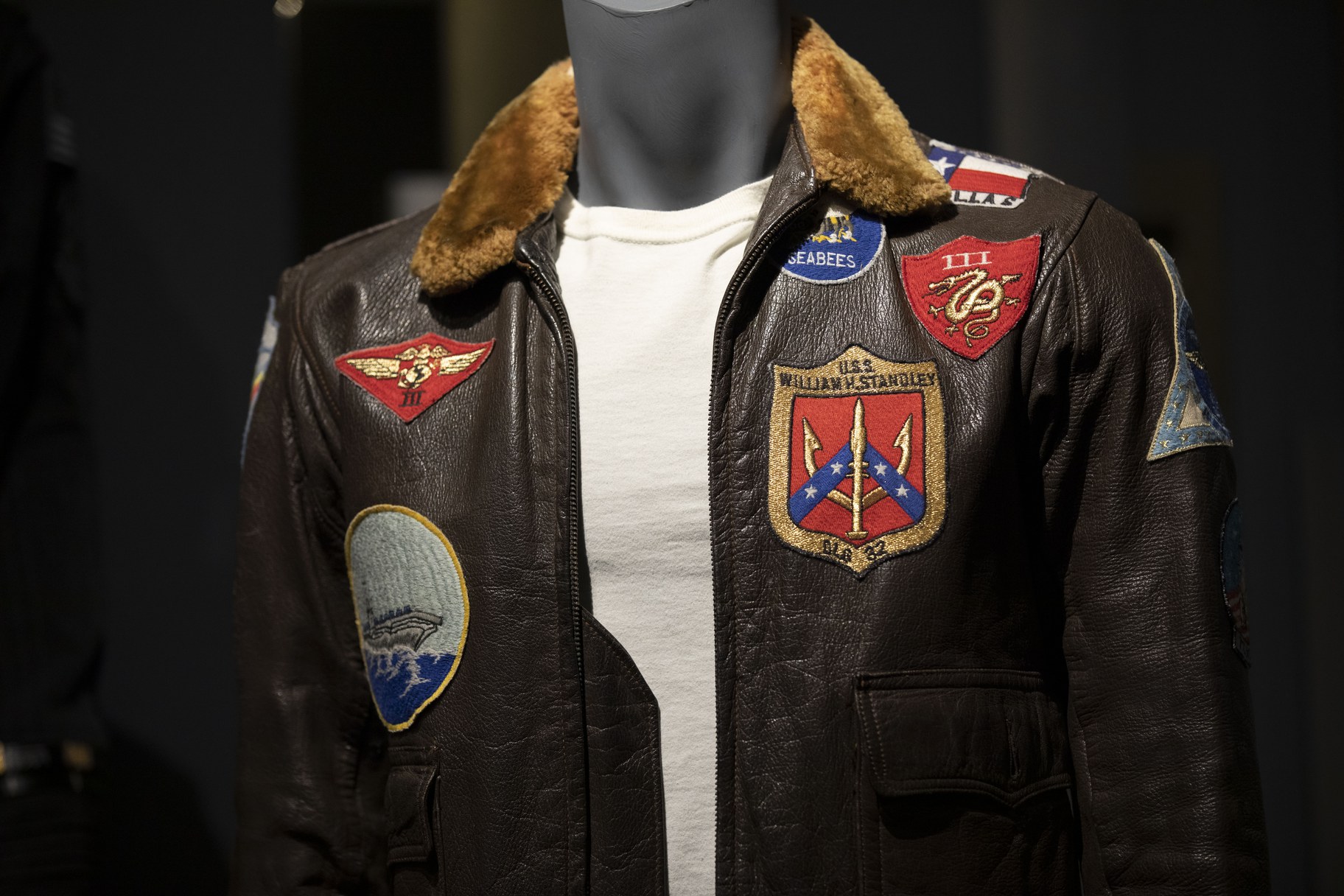
FIDM Chair of Fashion Design Nick Verreos says this flight jacket from the movie “Top Gun: Maverick” on display at the exhibit was made with elements from 40 period pieces. Photo by Alex J. Berlinger/ABImages, courtesy of the FIDM Museum.
What do you think about the designs from “The Northman?”
The colors surprise me, and also the texture, the fabrications, and all of that richness really.
One of my favorite costumes on display is from the movie and [the singer Bjork] wore it. She plays the Seeress. It’s like a witch so she's wearing this headdress and this beaded necklace. Lots of beads and bells.
The costume is very rich and impressive, but she felt it wasn't impressive enough. The night before they filmed her scene, she wanted to add chicken feet. So she [told] the prop department that she needed more in that necklace, and to get her some chicken feet and they got her some plastic chicken feet. So when you come to the exhibition, and you see her costume, just take a look at that necklace of hers. It's got something special.
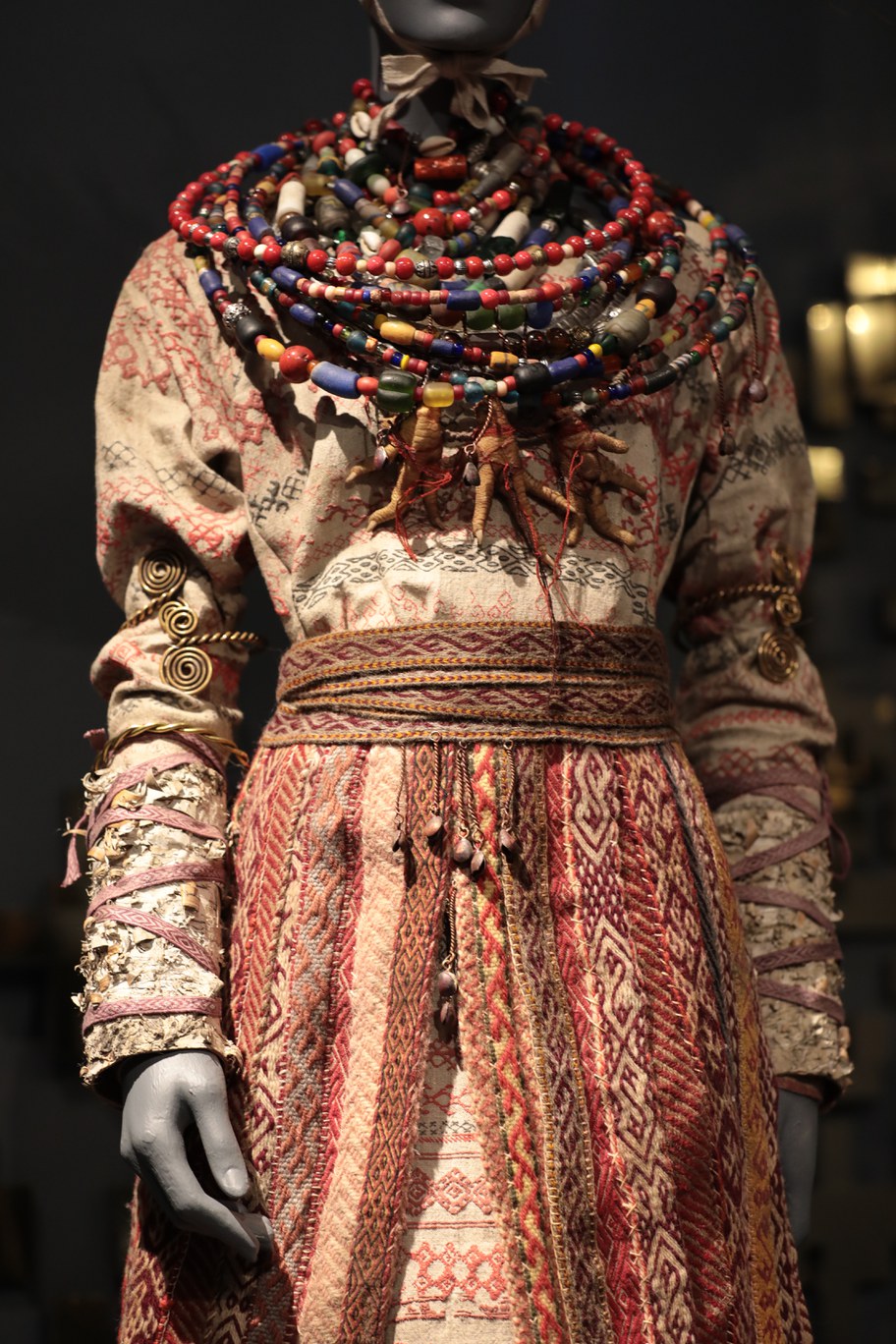
On display at the exhibit is the costume that singer Bjork wore in the movie “The Northman.” Visitors can see her elaborate costume, including the necklace that she requested be embellished with plastic chicken feet. Photo by Alex J. Berlinger/ABImages, courtesy of the FIDM Museum.
What’s special about the tuxedo on display that Cate Blanchett wore in “Tár?”
The fit is incredible. I believe the costume designer really wanted to convey what we know as conductors and what they wear: the tuxedo, the black and white, but let's make it for Cate Blanchett. The tuxedo is such an iconic sort of masculine staple of clothes, but when you put it on a woman, and somebody like Cate Blanchett — a powerful strong figure — it really conveys strength. It really throws away any sort of rules [around] masculine and feminine.
It's all in the details and it's especially impressive because when she's conducting, you get these close ups of the hands and the movement. So I think it's really important for the costume designer to think “where's the camera gonna shoot?” It shoots into the cuffs, it shoots with the three- quarter frame — the waist up. You get to see those details: the collar, the white shirt underneath, the satin lapel, all of that.
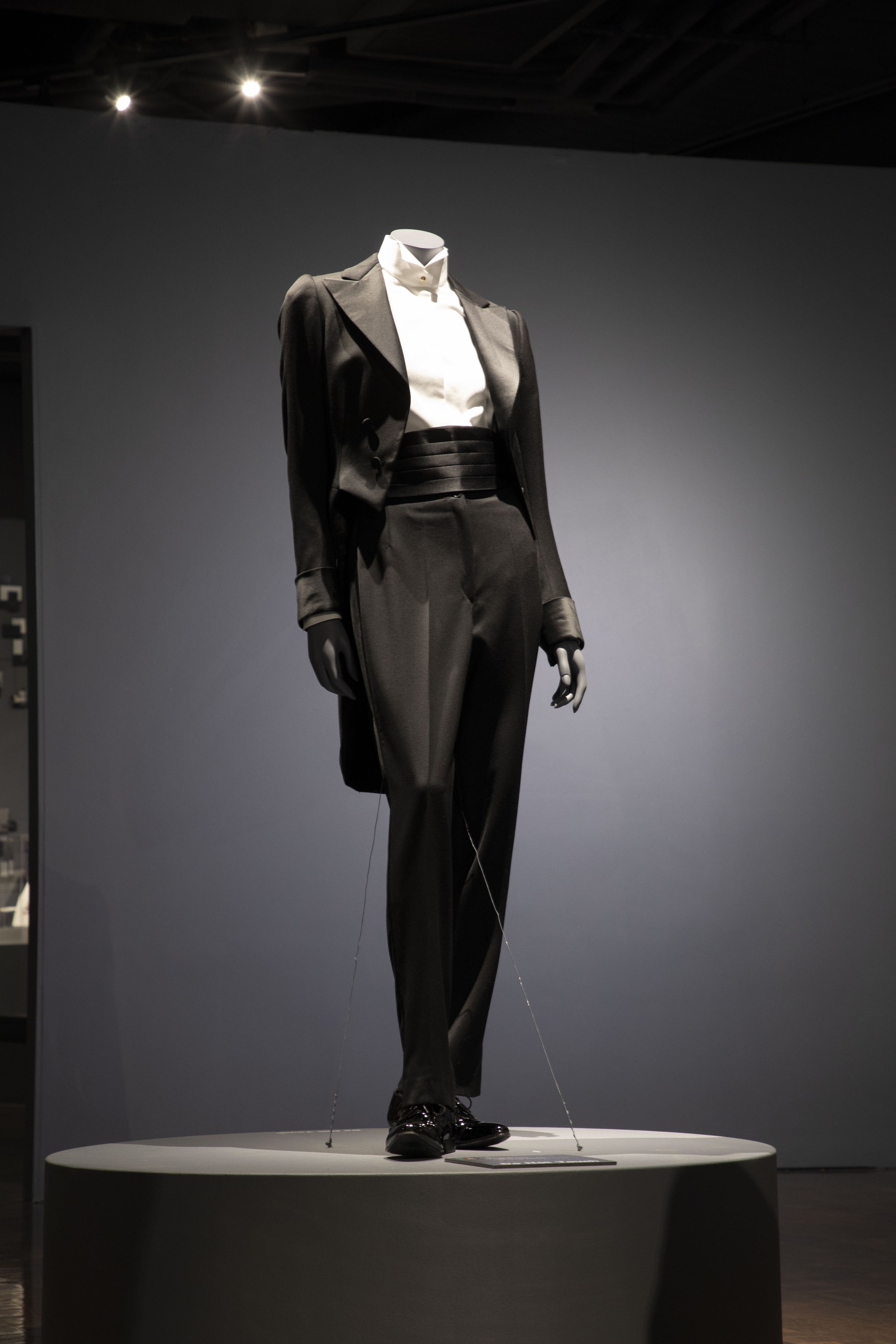
Cate Blanchett’s tailored suit is one of the costumes from the movie “Tár” that visitors can see at the FIDM exhibit. Photo by Alex J. Berlinger/ABImages, courtesy of the FIDM Museum.
